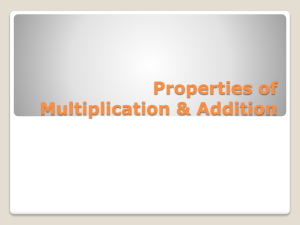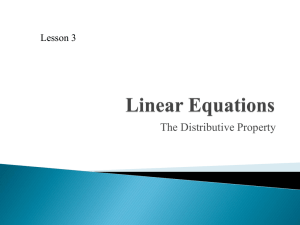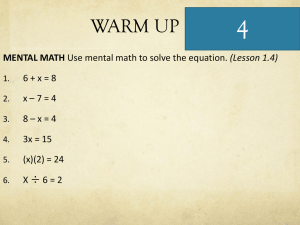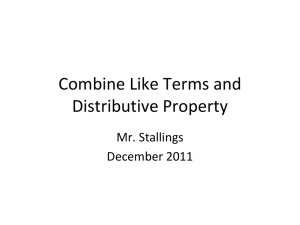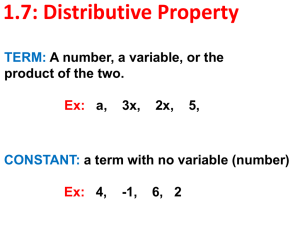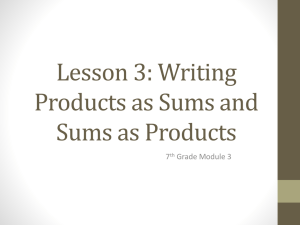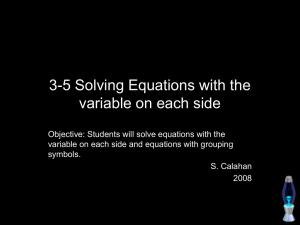Algebra 2 Name
advertisement
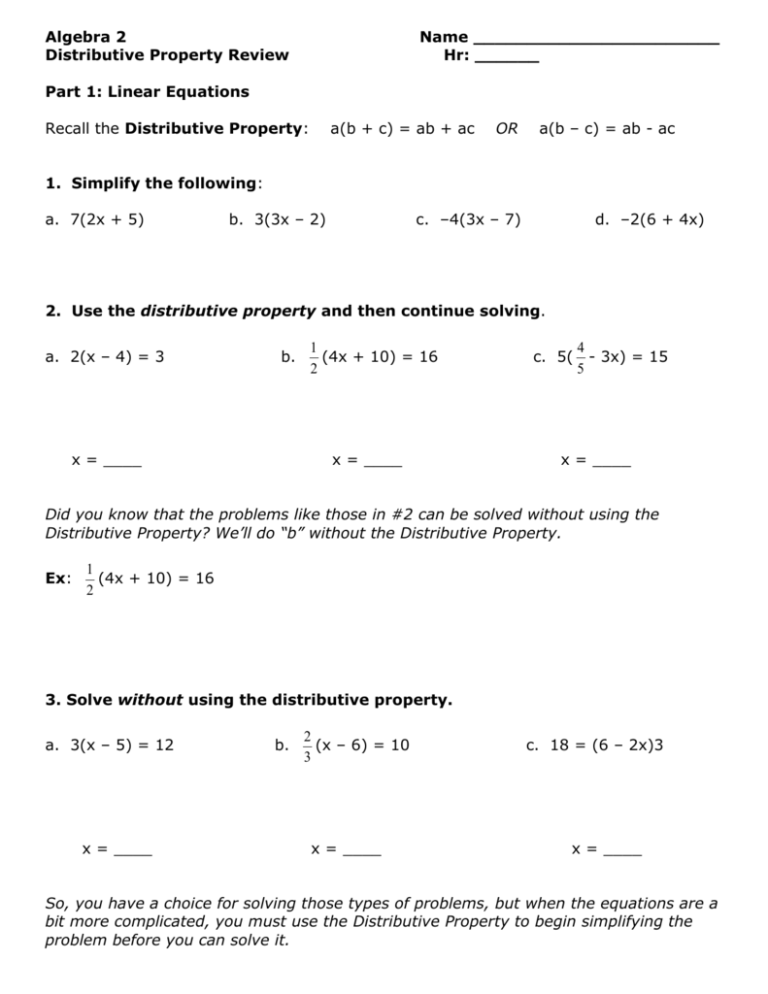
Algebra 2 Distributive Property Review Name _______________________ Hr: ______ Part 1: Linear Equations Recall the Distributive Property: a(b + c) = ab + ac OR a(b – c) = ab - ac 1. Simplify the following: a. 7(2x + 5) b. 3(3x – 2) c. –4(3x – 7) d. –2(6 + 4x) 2. Use the distributive property and then continue solving. a. 2(x – 4) = 3 b. x = ____ 1 (4x + 10) = 16 2 x = ____ c. 5( 4 - 3x) = 15 5 x = ____ Did you know that the problems like those in #2 can be solved without using the Distributive Property? We’ll do “b” without the Distributive Property. Ex: 1 (4x + 10) = 16 2 3. Solve without using the distributive property. a. 3(x – 5) = 12 x = ____ b. 2 (x – 6) = 10 3 x = ____ c. 18 = (6 – 2x)3 x = ____ So, you have a choice for solving those types of problems, but when the equations are a bit more complicated, you must use the Distributive Property to begin simplifying the problem before you can solve it. Ex: –3(-8 – 4x) + 2(4 + 3x) = 40 Don’t forget to combine like terms. 4. Simplify using the Distributive Property and then solve the following equations. a. 5(-3x – 7) + 4(9 – 2x) = -22 b. 12(3 + x) = 5(2x + 8) x = _____ x = _____ c. 3(x + 7) = 2(x + 9) d. 2(x + 6) + (-x + 5) = -8 x = _____ x = _____ Sometimes students have difficulty with a simple subtraction sign before the parentheses. Ex: 8x – (3x + 5) Correct: The subtraction sign in front of the parentheses here means that the whole sum of 3x + 5 should be subtracted from the product 8x. 8x – 3x – 5 Incorrect: 8x – 3x + 5 If you simplify correctly, 8x – (3x + 5) and 8x – 3x – 5 should result in the same number if you know the value of x. Let x = 2 and simplify the following: 8x – (3x + 5) 8x – 3x – 5 8x – 3x + 5 5. Write equivalent expressions using the Distributive Property. a. 4x – (x + 5) b. 17x – (5x – 9) c. (15x + 7) - (x + 4) _____________ _______________ ___________________ d. (5x + 8) – (2x – 7) e. (7x – 9) – (3 – 2x) ________________ _________________ f. –(6 – 9x) – ( 11 + x) ___________________ For 5d – f, use your simplified expression and let x = 2 to simplify further. 5d. 5e. Check your work: 5d should equal 21. 5f. 5e should equal 6. 5f should equal –1. So far you have used the Distributive Property to multiply a number through parentheses. Did you know that the Distributive Property can be used to FACTOR an expression? Ex: Factor 4x - 20 The idea is to find a common factor between 4 and 20 and divide it out. 2x 6 . Distribute the 3 to both terms in 3 2x 6 6 2x . Now you can reduce and the expression becomes 2. the numerator: 3 3 3 3 Or you may want to simplify an expression like 6. Factor or simplify the following using the Distributive Property. a. 3x + 18 b. –6x – 36 c. 14 x 2 7 d. 15 3x 3 Why would you do such a thing? Later in the year we will be learning to write equations in different forms and this skill will become necessary at that point. We have covered every facet of the Distributive Property for linear equations. You should be experts and able to solve the following equations without a problem. The idea is to take your time and think about the next step, and keep your columns neat and orderly. 7. Practice: Solve the following showing all work. a. 5(8x – 3) = 10(x – 4) b. -2(5 + 6x) + 16 = -90 x = ______ c. 22 – 5(6x –1) = -63 x = ______ d. 4x + 5(7x – 3) = 9(x – 5) x = ______ e. 3 – (4x + 1) = 7 + (3 + 2x) x = ______ x = ______ f. 1 1 5 1 x + 2( x - ) = 3 3 6 6 x = ______ Part 2: Quadratic Expressions Distributive Property can be used for multiplying expressions together as well. (a + b)(c + d) = ac + ad + bc + bd We call this method FOIL which stands for First, Outer, Inner, Last. These are actually the directions for the multiplication you will need to do. Ex: (2x – 7)(4x + 3) First, in each expression is 2x and 4x. Outer is 2x and 3. Inner is –7 and 4x. Last, in each expression is –7 and 3. Once you find the 4 products from FOILing, then combine like terms. What you’re really doing here is using the Distributive Property twice. Sometimes this process is called Double Distribution. It looks like this: (2x – 7)(4x + 3) 2x(4x + 3) – 7(4x + 3) Now use the Distributive Property and combine like terms. Another way of approaching this type of problem is using the AREA METHOD or BOX METHOD. It’s the same thing as either of the methods above, but it is a nice way of organizing your work. When finding the area of a square or rectangle, the length and width are multiplied together. Ex: 2x 2x(3x + 1) = 6x2 + 2x 3x + 1 is the area of the rectangle given. If x = 2 inches, the area is 6(2)2 + 2(2) = 28 in2 We can use this idea to multiply expressions together. (3x + 4)(2x – 5) 3x + 4 Each term, 3x, 4, 2x, and –5, become a length or width of a box. 2x Find the “area” (length width) of each “box” and then combine like terms. -5 answer: _________________________ 8. Practice: You are allowed to use any of the methods above to simplify the following quadratic expressions. Please do so, showing all work. a. (x – 2)(x – 9) d. (7x – 4)(3x + 6) b. (2x + 4)(x + 1) c. (3x + 7)(3x - 7) e. (2x + y)(x + 3y) f. (7x + 3y)(x + 2y) Important news bulletin: (2x – 1)2 is the same as (2x –1)(2x –1); NOT 2x2 – 12. Continue simplifying. g. (2x – 1)2 h. (3x + 9)2 i. (4x – y)2
